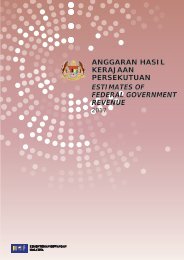WEALTH
2c0esX1
2c0esX1
Create successful ePaper yourself
Turn your PDF publications into a flip-book with our unique Google optimized e-Paper software.
FOCUS<br />
For its part, Indonesia launched the world’s<br />
largest single-payer healthcare insurance<br />
program in 2014. The aim of the program is<br />
to provide healthcare to all 247 million citizens<br />
by 2019 at an annual cost of $15 billion – about<br />
$60 per head.<br />
THE GOVERNMENT DILEMMA<br />
What is driving improvements is the economic<br />
development of low- to middle-income countries.<br />
The World Bank estimates that healthcare<br />
expenditure rose in East Asia (the countries<br />
stretching from China to Papua New Guinea)<br />
from 3.3 to 5.3% of GDP between 1995 and 2014.<br />
Although still only half the expenditure of the<br />
European Union and less than a third of North<br />
America, this will continue to rise.<br />
The reason is the further expansion of<br />
social security programs, as well as individual<br />
spending. According to the OECD, as Asia<br />
becomes more prosperous, the middle class<br />
will balloon from 525 million in 2009 to 3.2<br />
billion by 2030. As the middle class becomes<br />
more affluent, it will want better healthcare,<br />
particularly to address the multiple diseases<br />
that accompany rising life expectancies. It is<br />
then, when chronic, old-age-related conditions<br />
hit families and friends, that people realize the<br />
greatest gift we all have is good health.<br />
This poses a problem: while Western<br />
countries have had up to 100 years to create<br />
broad healthcare safety nets for citizens, Asia<br />
has only a few short decades to use its<br />
demographic bounty before it becomes old (see<br />
PROJECT M #21, “A title no country wants”).<br />
Governments still in the process to deliver<br />
basic medical services may not be able to<br />
afford to devote limited public funds to the<br />
construction of costly healthcare services<br />
along Western lines. As the Indonesian polio<br />
outbreak highlighted, even when healthcare is<br />
within reach, people may not access it. Reasons<br />
range from overcrowding to insufficient<br />
resources; some public schemes do not cover<br />
informal workers. Limited coverage and copayments<br />
mean people cannot always afford<br />
necessary medical services.<br />
The scheme in the Philippines, for example,<br />
does not cover drugs: patients must choose<br />
between paying out-of-pocket expenses and<br />
going without. Not infrequently, such costs<br />
can have severe consequences. People use<br />
savings, sell assets such as their homes, or<br />
borrow to meet medical bills. If the illness hits<br />
the head of the family, it usually means loss of<br />
income. All of this can push families into longterm<br />
financial distress. Limited government<br />
funds are better spent providing<br />
comprehensive basic universal healthcare<br />
services for all citizens. To address out-ofpocket<br />
expenses, government schemes have to<br />
balance the need for indemnity covers against<br />
the available funds by focusing on delivering<br />
core medical requirements at responsible<br />
quality standards. The target should always be<br />
to improve the health status of the population<br />
and prevent people from falling into poverty<br />
through illness.<br />
VOLKER STÜVEN<br />
is the regional head of<br />
Health Business at Allianz<br />
Asia Pacific (AZAP) based<br />
in Singapore. In his<br />
previous positions, he<br />
was general manager of<br />
Allianz Life & Pension in<br />
Turkey (2012-2014).<br />
Volker studied economics<br />
and holds a PhD from the<br />
Kiel Institute of World<br />
Economics<br />
GREATER AFFORDABILITY<br />
The healthcare demands of citizens over and above a basic layer of<br />
healthcare can be met through private insurance. Up to now, private<br />
health insurance has played a minor role in most Asian markets, with<br />
governments providing varying degrees of public healthcare.<br />
Yet experience in countries around the world shows, that as the<br />
middle class increases its buying power, people are prepared to use the<br />
risk-pooling mechanism that insurance provides to protect themselves<br />
and their families against potentially high healthcare costs, and secure<br />
broader and better coverage. This process is already taking place, for<br />
example, in Malaysia and Thailand. Both countries have developed a<br />
well-regarded healthcare infrastructure supported by public financing.<br />
Both countries are also seeing continual strong growth in private health<br />
insurance and an expanding private healthcare sector.<br />
This trend will see private insurance uptake continue to grow in<br />
Asia. Growing numbers of people will seek higher quality healthcare<br />
with ready access in preference to facing long waiting lists at public<br />
facilities. They will want insurance solutions and services to protect<br />
themselves and support their well-being throughout their longer lives.<br />
And they will seek to insure themselves against out-of-pocket expenses<br />
that can arise from special critical illnesses where treatments can<br />
devastate even prosperous, middle-class families.<br />
MULTI-PILLAR HEALTH COVERAGE<br />
The development of private health insurance is complementary with the<br />
aspiration for universal healthcare. A multi-pillar approach with a<br />
voluntary private health insurance component can provide strong<br />
support to the development of a public layer that is well-regulated and<br />
adapted to local needs. Asian governments are realizing this and are<br />
encouraging greater use of private health insurance through market<br />
liberalization. As populations grow wealthier, and become more aware<br />
of the risk pooling benefits of insurance, uptake will increase even in the<br />
mass-affluent segment.<br />
16 • Allianz



